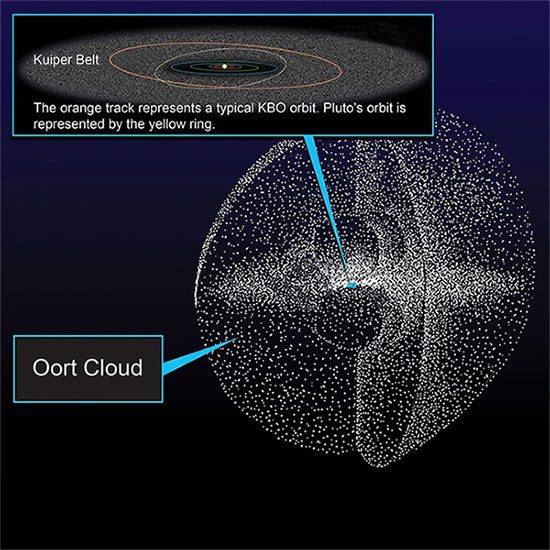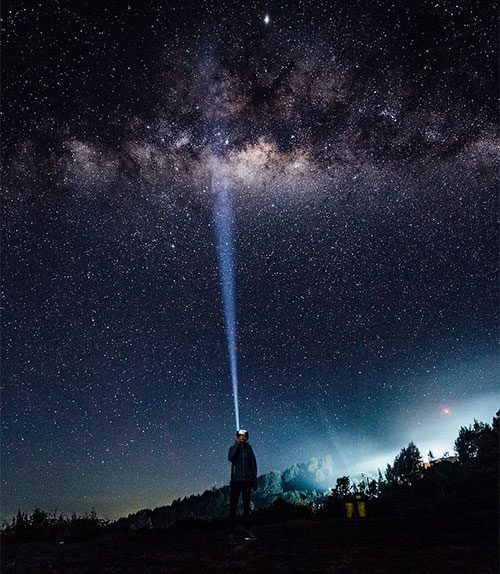The common understanding in the modern scientific community is that there exists a Oort Cloud beyond the Solar System, consisting of large and small icy bodies formed from a mixture of water vapor and dust, known as comets, that surround the Sun in a sphere with a radius of about 1 light-year.
However, this is a hypothetical cloud, with estimates suggesting there are up to 10 trillion cometary particles in this cloud, but they are scattered across a vast space that is 1 light-year thick. This sparsity is beyond human imagination, so it does not affect the observations of scientists.

NASA describes the giant Oort Cloud as an “enormous bubble with thick walls made up of icy space debris the size of mountains, and sometimes larger.” The Oort Cloud is named after the Dutch astronomer Jan Hendrik Oort, who discovered the cloud in the 1950s while investigating why some comets in the Solar System have elongated orbits.
A light year is a measure of distance, simply put, it is the distance that light travels in one year. Specifically, light travels at a speed of 299,792,458 meters per second in a vacuum, meaning a Julian year has a length of about 9.46 trillion kilometers.
Because the Solar System has a radius of 1 light year, theoretically, if you shine a flashlight into space, the beam of light would not escape the Solar System in a short time; instead, it would take an entire year to reach the edge of the Oort Cloud within the Solar System before finally exiting the Solar System.
However, the issue is that the beam from the flashlight will diminish; as the movement of photons encounters various charged particles, they will interact with each other. Consequently, the light will be reflected, refracted, and absorbed by different charged particles, with the motion of the photons colliding with particles and being absorbed multiple times in a very short time, thus the faint light from the flashlight will disappear in less than a second after the light is turned off.

Gamma-ray bursts occur almost daily, appearing suddenly and lasting only for a few brief seconds. There is still not much documentation to study them, so the sources of these bursts remain a mystery. Scientists believe they originate from neutron star collisions or supernova explosions—moments when a star runs out of energy, collapses under its own gravity, and becomes a neutron star or black hole.
Even in the space beyond Earth, it seems to be in a high vacuum state, but there is no absolute vacuum in the universe, thus the faint light from the flashlight will quickly dissipate in space.
A light source emitting more photons means the energy of the photons is greater, allowing them to travel further. This is why the light from larger stars can reach farther, even hundreds of millions of light years away, and can be observed with telescopes. The more energy a galaxy radiates, the farther its light travels; gamma-ray bursts are the highest energy light, capable of traveling billions of light years.
According to Science Times, gamma-ray bursts are known as the most powerful and brightest explosions in the universe. Scientists believe these super-bright flashes are produced during the formation of black holes and emit energy equivalent to that which the Sun emits over 10 billion years. The first gamma-ray burst was detected in July 1967 during the peak of the Cold War. The U.S. launched satellites into space to detect Soviet nuclear weapons, and two satellites named Vela 3 and Vela 4 observed the fleeting flashes of high-energy photons, known as gamma rays. Gamma-ray bursts typically last from a few seconds to a few minutes, originating from the formation of a black hole associated with a supernova being beamed or neutron star collisions. A gamma-ray burst can release an amount of energy equivalent to what is produced in a supernova, but within a few seconds or minutes rather than weeks. Their peak brightness can be 100 billion times that of the Sun and a billion times that of the brightest supernovae. According to NASA, there are two types of gamma-ray bursts: long gamma-ray bursts and short gamma-ray bursts. Long bursts can last from 2 seconds to several minutes, averaging around 30 seconds. This type is associated with the massive collapse of stars, although not all supernovae produce gamma-ray bursts. Short bursts last from a few milliseconds to 2 seconds, averaging around 0.3 seconds. They are associated with the merger of a neutron star with a completely new black hole or with a black hole from a larger black hole. |


















































